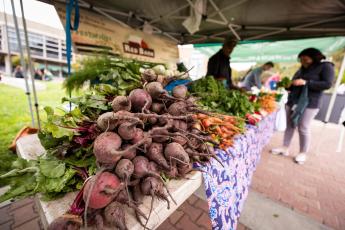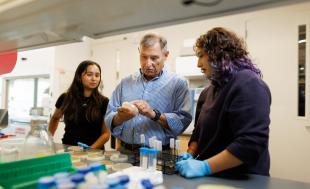Ask an Expert: How Will Climate Change Shape California's Food Future?

It’s no secret that climate change will impact every facet of our lives, from where we live to how we prepare for natural disasters. But what about our food? In the spring, Anastasia Telesetsky, a professor in the Natural Resources Management and Environmental Sciences Department, received a grant from an ambitious statewide initiative called

California 100 to lead research exploring the past, present and future of California food systems and consider potential future scenarios for California food production systems.
Among other things, Telesetsky and her students found hope for California’s food future — and a grim warning if California fails to plan. Telesetsky sat down with Cal Poly News to speak more about the research and the potential implications for the Golden State.
What is the broad overview of the project?
The California 100 organization commissioned a series of reports on different aspects of California life that range from housing to foreign policy to, in this case, food systems. What we were asked to do was provide a research report looking at the state of affairs of food production and the supply system in California. We looked at everything from agribusiness to the distribution of food and we identified some of the pressures on the systems.
My focus, and the focus of the report, is largely on the limitations associated with water, but we also looked at warming temperatures and other constraints.
Food is already getting more expensive, so it has the potential to be a long-term food security issue, given the kind of prominence California has had over the last several decades in agricultural production. A big part of the research involved creating scenarios, looking at potential future scenarios and thinking about the major drivers that are likely to impact food systems over the course of the next three to four decades.
What did the research entail?
California 100 asked all of the research authors to look at two potential driving factors. The two we looked at were availability of water for food production and whether California is able to adapt food production systems to a warming climate with less rainfall.
We collected facts associated with California food production, looked at California history for the origins of the situation and studied trends. Some of the trends include new food consumption patterns, like the rise of alternative proteins such as plant-based burgers.
There's a lot of talk about carbon capture, which would pull carbon out of the environment, but at this point that’s still kind of a pipe dream. It’s not going to come online quickly enough to be able to avoid some of warming trends California is experiencing and will continue to experience.
The water issue is a top priority for the California legislature, and there’s a lot of work producers are voluntarily doing, but if we do not get a handle on water resources and responding to a warming climate, our reality will be that California’s industry is unlikely to pivot and we’ll be in a very dire scenario.
Based on the research, what could the future of food production in California look like?
It depends on the scenario. We identified four scenarios that are possible depending on how much water there is and how well California’s adapts to warming temperatures.
The first scenario is status quo, where everything remains as it is right now. This scenario is called Selling the Farm, and it really doesn’t look good for California. We need to find ways of ensuring there is more management of the water we do have and accessing new sources of water. That could mean desalination of ocean or ground water, but possibly water markets as well. That means we could be trading with states that are receiving more water than they could use, or we could trade within the state if regions of California have surplus water.
We call the second scenario Canadian Hothouse Tomatoes and Mexican Avocados. In this scenario, we would offshore California’s food production. California would no longer be making the kind of investments it has from private industry because other places would have a comparative advantage in creating products California has traditionally been a major exporter of.
The third scenario is Land of Milk and Honey. In this scenario, the state is proactive in making investments in water supply and adapting to climate shifts. We need even more renewable energy investments than we currently have coming online so that we will have the energy to recycle wastewater, potentially desalinate, or maybe even move water from eastern states to western states.
The final scenario is called Innovation Nation, where a warming California begins to think about producing different kinds of foods in indoor environments and improving its biotech to be able to able to rely on drought resistant crops. However, in order to do that, we’d need to make investments in renewable energy production because it’s too expensive to do this using conventional energy sources.
What are the potential long-term impacts of the Selling the Farm Scenario?
It will mean more expensive food, less variety in food and it may eventually mean less nutrition. We currently have a disparity where not all California residents have equal access to healthy nutritious food, but if this future comes to pass we will see even greater disparities.
In terms of the food system itself, that system employs people all the way down the supply chain. It goes all the way down to folks who work in processing plants, people who transport food to stores and supermarket workers. There will be a real ripple effect if food systems begin to implode here in California.
You’ll see major impacts. This is not simply about people who are farm owners or farm laborers in the field. California employs a tremendous number of people in restaurants. Right now, smaller restaurants can get food quickly — either direct from a farm or from a wholesaler based here in California — but that wouldn’t be the case anymore.
We would have to rely on other states to supply California’s food. As one of the more populous states in the United States, that could be quite problematic, particularly for perishable foods. The quality is likely to go down because there will be longer transit times, which means more impact in terms of greenhouse gases.
Why is it important to do this kind of research?
I think this kind of work gives us an opportunity as a community, as Californians, to reflect on some of the hard choices that we need to make. The question is, where are we going to put investments and where should we be encouraging the private sector to put in more effort?
California has always led: this is the first state where we saw hybrid cars and rooftop solar. This is an opportunity for California to lead again. A lot of other states depend on California. Today, if you’re in Minnesota, you can get strawberries in December because they come from Southern California.
This planning is key to ensure that we don’t lose our agricultural sector and that it has a future.
What is your hope for this project and research? What do you hope people take away from it?
I hope people take away a sense of hope that there are things we can do. Those things will require long-term focused investment and they will require Californians coming together and looking for common good and common ground in order to be able to ensure that future generations of Californians have access to nutritious, high-quality food.
We’re likely to be pivoting away from some long-term industries. There will continue to be a cattle industry in California, but we may be investing more in getting protein from other sources. This is something that is doable and achievable, but it really depends on making sure we have policy incentives for basic foods.
For instance, even though nuts are a very, very economically desirable crop and a major global export for California, nuts require a lot of water and acreage. We may have to move resources away from producing nuts for export and put our resources into equally nutritious but less economically desirable crops for our domestic market.
Looking at our equity issues, we must focus on making sure that California is feeding high-quality, nutritious food to Californians. It goes without saying that nutrition is absolutely essential to the future of California. It’s a public health issue.
Anything else you’d like to add?
I think this next generation of students, especially our students in CAFES, have the power to change our food system. They’ve got the skills. Tomorrow’s food system is not going to be the same as yesterday’s, and I think that’s a key point of this report. Students should be seeking ways to advance the future of food production because at the end of the day that will ensure long-term sustainability here in California and elsewhere.




